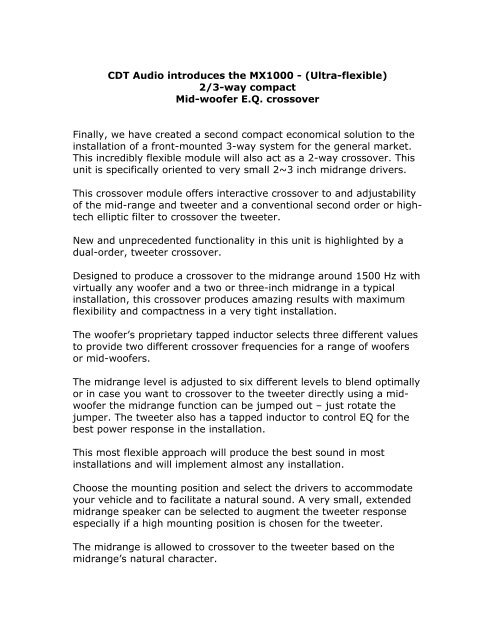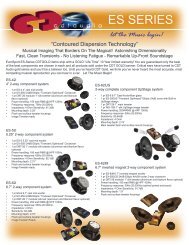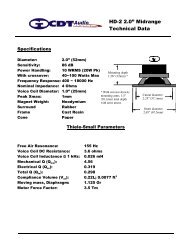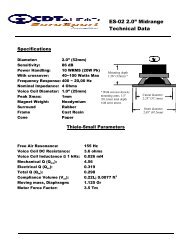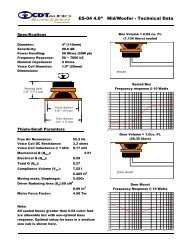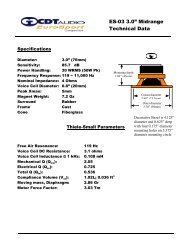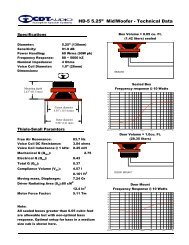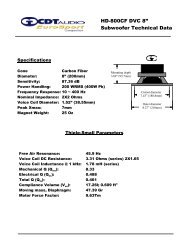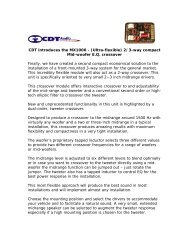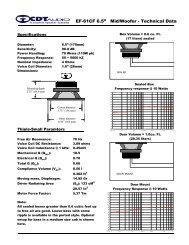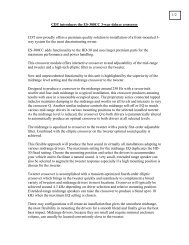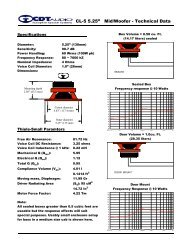MX-1000 - CDT Audio
MX-1000 - CDT Audio
MX-1000 - CDT Audio
You also want an ePaper? Increase the reach of your titles
YUMPU automatically turns print PDFs into web optimized ePapers that Google loves.
<strong>CDT</strong> <strong>Audio</strong> introduces the <strong>MX</strong><strong>1000</strong> - (Ultra-flexible)2/3-way compactMid-woofer E.Q. crossoverFinally, we have created a second compact economical solution to theinstallation of a front-mounted 3-way system for the general market.This incredibly flexible module will also act as a 2-way crossover. Thisunit is specifically oriented to very small 2~3 inch midrange drivers.This crossover module offers interactive crossover to and adjustabilityof the mid-range and tweeter and a conventional second order or hightechelliptic filter to crossover the tweeter.New and unprecedented functionality in this unit is highlighted by adual-order, tweeter crossover.Designed to produce a crossover to the midrange around 1500 Hz withvirtually any woofer and a two or three-inch midrange in a typicalinstallation, this crossover produces amazing results with maximumflexibility and compactness in a very tight installation.The woofer’s proprietary tapped inductor selects three different valuesto provide two different crossover frequencies for a range of woofersor mid-woofers.The midrange level is adjusted to six different levels to blend optimallyor in case you want to crossover to the tweeter directly using a midwooferthe midrange function can be jumped out – just rotate thejumper. The tweeter also has a tapped inductor to control EQ for thebest power response in the installation.This most flexible approach will produce the best sound in mostinstallations and will implement almost any installation.Choose the mounting position and select the drivers to accommodateyour vehicle and to facilitate a natural sound. A very small, extendedmidrange speaker can be selected to augment the tweeter responseespecially if a high mounting position is chosen for the tweeter.The midrange is allowed to crossover to the tweeter based on themidrange’s natural character.
Tweeter crossover is accomplished with either a fast fifth-order ellipticthat brings in the tweeter quickly and invisibly to complement a broadvariety of tweeters and midrange drivers in most locations or if aparticular installation requires it a slower second-order transition isalso available.Crossover will typically be achieved around 3~5 kHz in 5 TH order modedepending on driver selection and relative mounting position. 2 nd ordermode with directed extended-range midrange speakers can raise thecrossover to produce a blend up to 10 kHz.Three-way configurations will create an installation that gives thesmoothest midrange, the most flexibility in mounting the drivers for asmooth blend and finally gives the best impact.The small midrange drivers used in this system require minimalenclosure volume and can be located in the most densely occupiedlocations.Installation of this unit is an adventure in a world of possibilities andcustom control.The following charts show what you can do with this device and thesefunctions can be used singly or combined.The EQ can be low for a flatter frequency response or high for a flatterpower response. This depends on where the tweeters are mounted. EQset to high accommodates indirectly aimed mountings.
Tweeter level settings – TW EQLO, TW MODE 5THTweeter level settings – TWEQ HI, TW MODE 5TH
Tweeter level settings – TW EQLO, TW MODE 2NDTweeter level settings – TWEQ HI, TW MODE 2ND
Midrange Level SettingsHI to LOWoofer Crossover FrequenciesLO, MED and HI
NOTE:Rotate the jumper in any woofer/midrange/tweeter section to deletethat function. The driver if connected to the following will mute whenthe jumper is removed or rotated.Woofer – X FREQMID LEVELTW LEVELIf a particular driver is not to be used the rotated orientation iscorrect. This does not apply to the EQ and MODE sections. The EQsection jumper may be set to “none” by placing it over just one pin.The MODE position marked 2 ND is the same as removing the jumper.The effect of selecting “none”, as described above, in the EQ sectionand on the tweeter responses is shown below.Tweeter level settings –TW EQ NONE, TW MODE5TH
Tweeter level settings –TW EQ NONE, TW MODE2NDOperation of the <strong>MX</strong><strong>1000</strong>The <strong>MX</strong><strong>1000</strong> will perform a host of separate or combined crossoverfunctions. Any driver may be left unused by rotating the jumper fromsideways to vertical to remove that driver from the amplifier asdescribed above. The MODE function can also be operated in the“none” position.The levels of the midrange and tweeter can be adjusted by attenuationover approximately a 10db range. The midrange crossover isapproximately 1kHz high pass and the low pass is left to the driver’snatural roll-off in whatever is the particular mounting position – it runsall the way up. The tweeter crossover can be set to approximately4kHz for two-way operation or 8kHz for three-way use with smallmidrange drivers generally 2~3inch size but 4 inches is also useable.Various contours between these two frequencies and some verygradual blends are also available. Tweeters require some EQ in almostall cases so the actual acoustic crossover can occur lower in frequencythan the crossover setting. This is especially true for gradual slopes.
Summarizing from the graphical curves the following amplitudes andfrequencies can be estimated. The woofer and midrange settings arerelatively straightforward. The tweeter gains can be modulated orshaped by different settings of the MODE and EQ jumpers.Jumper: WFR X FREQLO: 500Hz first order to 2kHz and second order above 2kHzMED: 2kHz second orderHI: 3.5kHz second orderJumper: MID LEVELHI: (position1) – crosses over at 1.5kHz second order with 0dBattenuation above 4kHzPosition 2 – crosses over at 1.3kHz second order with 2dB attenuationabove 4kHzPosition 3 – crosses over at 1.25kHz second order with 4dBattenuation above 4kHzPosition 4 – crosses over at 1.2kHz second order with 6dB attenuationabove 4kHzPosition 5 – crosses over at 1.1kHz second order with 8dB attenuationabove 4kHzPosition 6 – crosses over at 1.0kHz second order with 10dBattenuation above 4kHzJumper: TW LEVEL (TW MODE –2 nd , TW EQ-HI)The crossover slope and driver characteristics will result in a loweracoustic crossover frequency than the numbers below – typically 0.7times lower.HI: (position1) – crosses over at 12kHz second order with 0dBattenuation ref. 20kHzPosition 2 – crosses over at 11kHz second order with 2dB attenuationref. 20kHzPosition 3 – crosses over at 10kHz second order with 4dB attenuationref. 20kHzPosition 4 – crosses over at 10kHz second order with 6dB attenuationref. 20kHzPosition 5 – crosses over at 10kHz second order with 8dB attenuationref. 20kHzPosition 6 – crosses over at 10kHz second order with 10dB attenuationref.20kHz
Jumper: TW LEVEL (TW MODE –5 th , TW EQ-HI)This setting gives a combination crossover that is 5 th order below 4kHzand varies as listed for each attenuation setting. The crossover willacoustically occur between the 5 th order frequency and the –3dBfrequency.HI: (position1) – crosses over at 4kHz 5th order and 12kHz 1 st order,0dB attenuation ref. 20kHzPosition 2 – crosses over at 4kHz 5th order and 11kHz 1 st order, 3dBattenuation ref. 20kHzPosition 3 – crosses over at 4kHz 5th order and 10kHz 1 st order, 5dBattenuation ref. 20kHzPosition 4 – crosses over at 4kHz 5th order and 9kHz 1 st order, 7.5dBattenuation ref. 20kHzPosition 5 – crosses over at 4kHz 5th order and 7kHz 1 st order, 10dBattenuation ref. 20kHzPosition 6 – crosses over at 4kHz 5th order and 7kHz 1 st order, 12dBattenuation ref. 20kHzJumper: TW LEVEL (TW MODE –2 nd , TW EQ-LO)The crossover slope and driver characteristics will result in a loweracoustic crossover frequency than the numbers below – typically 0.7times lower.HI: (position1) – crosses over at 10kHz second order with 2dBattenuation ref. 20kHzPosition 2 – crosses over at 8kHz second order with 3.5dB attenuationref. 20kHzPosition 3 – crosses over at 7 kHz second order with 5.5dB attenuationref. 20kHzPosition 4 – crosses over at 6.5kHz second order with 7.5dBattenuation ref. 20kHzPosition 5 – crosses over at 6kHz second order with 9.5dB attenuationref. 20kHzPosition 6 – crosses over at 5.5kHz second order with 11dBattenuation ref.20kHzJumper: TW LEVEL (TW MODE –5 th , TW EQ-LO)This setting gives a combination crossover that is basically 5 th orderbelow 4kHz and varies as listed for each attenuation setting. Thecrossover will acoustically occur close to the 4kHz frequency exceptthe higher gains offer some EQ that could raise the crossover slightlyto perhaps 5~6kHz in the two highest gains. This is the typical twowayelliptic crossover.
HI: (position1) – crosses over at 4kHz 5th order and 6kHz 1 st order,1.5dB attenuation ref. 20kHzPosition 2 – crosses over at 4kHz 5th order and 5kHz 1 st order, 3dBattenuation ref. 20kHzPosition 3 – crosses over at 4kHz 5th order, 5dB attenuation ref.20kHzPosition 4 – crosses over at 4kHz 5th order, 7.5dB attenuation ref.20kHzPosition 5 – crosses over at 4kHz 5th order, 9dB attenuation ref.20kHzPosition 6 – crosses over at 4kHz 5th order, 11dB attenuation ref.20kHzJumper: TW LEVEL (TW MODE –2 nd , TW EQ-“none”)The crossover slope (1 st order) and driver characteristics will result in alower acoustic crossover frequency than the numbers below – typically0.5 times lower. This offers a very gradual slope to tweeters withferrofluid or others with a flat impedance curve.HI: (position1) – crosses over at 10kHz second order with 2dBattenuation ref. 20kHzPosition 2 – crosses over at 9kHz second order with 4dB attenuationref. 20kHzPosition 3 – crosses over at 7 kHz second order with 5.5dB attenuationref. 20kHzPosition 4 – crosses over at 6kHz second order with 7.5dB attenuationref. 20kHzPosition 5 – crosses over at 5kHz second order with 9dB attenuationref. 20kHzPosition 6 – crosses over at 4.5kHz second order with 11dBattenuation ref.20kHzJumper: TW LEVEL (TW MODE –5 th , TW EQ-“none”)This setting gives a combination crossover that is basically 4 th orderbelow 4kHz and varies as listed for each attenuation setting. Thecrossover will acoustically occur close to the 4kHz frequency exceptthe higher gains offer some EQ that could raise the crossover slightlyto perhaps 5~6kHz in the two highest gains. This resembles the EQ-LO, MODE-5 th response but rolls off more gradually below 4kHz.HI: (position1) – crosses over at 4kHz 5th order and 6kHz 1 st order,1.5dB attenuation ref. 20kHz
Position 2 – crosses over at 4kHz 5th order and 5kHz 1 st order, 3dBattenuation ref. 20kHzPosition 3 – crosses over at 4kHz 5th order, 5.5dB attenuation ref.20kHzPosition 4 – crosses over at 4kHz 5th order, 7dB attenuation ref.20kHzPosition 5 – crosses over at 4kHz 5th order, 9dB attenuation ref.20kHzPosition 6 – crosses over at 4kHz 5th order, 11dB attenuation ref.20kHz


